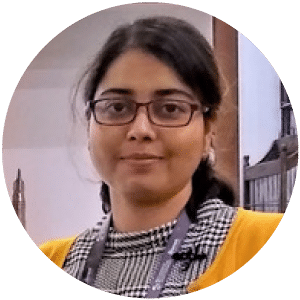- Project in progress
- CEA-SI-2022-004
Biomedicalengineer Swati Banerjee probes brain’s frugal sensory processing “algorithms”

Swati BANERJEE
“Frugal Brain is benefiting directly from the CEA’s culture of cooperation between scientists and engineers in vastly different disciplines.”
Banerjee and her team will use EEG measurements of brain activity to probe the mechanisms that underpin sensory integration and understand the “algorithms” that power the most resource-efficient computer around—the human brain.
The measurements will be used to build a model that could lead to a deeper understanding of certain neurological diseases and inspire new and more frugal technologies.
For Banerjee, the Frugal Brain project is the latest incarnation of a lifelong quest for knowledge that started when she was just a child.
Painting a picture of the brain’s “algorithms” with EEG data
During the Frugal Brain project, Banerjee and her team will advance the use of physiological data for diagnostics using multi-scale data-driven modelling and analysis and investigate the interactions between the different sensory modalities (visual, auditory, and haptic) in the human brain and—specifically—the tradeoffs the brain makes between these modalities to make decisions efficiently. The idea is to come up with a framework to describe these sensory integration shortcuts so that they can be applied to artificial systems for medical diagnostics, for example.
Banerjee’s technique of choice will be non-invasive electroencephalography (EEG)—much more accessible than fMRI (functional magnetic resonance imaging), a neuroimaging technique commonly used for sensory integration research. While EEG data is much lower in resolution than MRI images, the machines are less expensive and easier to deploy, potentially opening the door to massive data collection. What makes this research unique is that EEG will be combined with new analysis methods to produce a powerful new model based on haptic, auditory, and visual cues—whereas most of the current studies only include auditory and visual modalities. In addition to understanding how the brain sifts through an overabundance of sensory inputs to find shortcuts, this novel approach could also tell scientists how the brain deals with gaps in sensory inputs. We know that people with visual impairments, for example, depend more heavily on their other senses. The question is, how do their brains actually do it?
The research could lead to new insights into the underlying patho-physiological conditions in certain brain disorders and, ultimately, enable earlier diagnosis, a deeper understanding of how these diseases progress, and better treatment.
For epilepsy, this new information could make it possible to pinpoint the early warning signs of a seizure in the brain and stop it before it occurs. But the potential applications are much broader.
Beyond the medical applications of the research, the framework developed could also support the design of biomimetic artificial systems that bring the frugality of the human brain to electronic devices like smartphones, IoT devices, industrial robots, and more.
Women leading women in science and engineering
The Frugal Brain project is being hosted by LISA, a multidisciplinary lab at CEA-List in Paris-Saclay led by Margarita Anastassova. LISA’s mission is to develop new sensory and ambient human-machine interfaces and innovative interaction modalities. “In terms of what we do at LISA, having a bioengineer like Swati here working on the neurosensory system is particularly valuable to our team,” said Anastassova.
And the work is pushing Banerjee, an engineer by training, into new disciplines. “The issues are multifaceted. A pharmacologist or oncologist is not going to look at a disease the same way I do. So, I have to constantly adapt. This is challenging, of course, but it is also stimulating.” Devices like sensors represent another—completely different—field. “Bridging these worlds is the very essence of translational research,” said Banerjee.
“Traditionally, the CEA has been dominated by the hard sciences like physics. Multidisciplinary labs like LISA that overlap with the humanities are a relatively recent development. It is exciting to break new ground, but we still have a long way to go,” said Anastassova.
Banerjee, whose PhD supervisor was a woman, was especially pleased to join a woman-led lab for her Science Impulse project. “Engineering, and technology in general, are still considered male-dominated fields. The chance to work closely with female scientists like Margarita is an inspiration,” said Banerjee.
Anastassova, a psychologist by training, said, “I work with engineers every day. I think it is important to tell young women, including ones coming from the human and social sciences, that there’s a place for them at research and technology organizations like the CEA. Having the right skills is vital, of course. But having more women with diverse backgrounds in our labs also brings advantages.”
Education, a family value that led Banerjee to a career in science
Banerjee got her first taste of science at home when she was just five. She and her father—who had studied physics and electrical engineering—would do their own kitchen table experiments, taking things apart to see how they worked. “I was fascinated by electronics and all the little colored resistors on a circuit board,” she says.
Banerjee’s parents encouraged her to study math, physics, and engineering. Although she did well academically, being one of the only female students in a mostly male cohort was socially isolating at times. After she graduated, she crossed paths with renowned female computer scientist Sanghamitra Bandyopadhyay, today the Director of the Indian Statistical Institute. “I was so impressed by her achievements. She was my first role model,” said Banerjee.
When asked why she applied for a Science Impulse fellowship, Banerjee said, “The CEA is pioneering artificial intelligence solutions for health. There is no better place to be to learn, grow, and contribute. I am thrilled to be here. Frugal Brain is benefiting directly from the CEA’s culture of cooperation between scientists and engineers in vastly different disciplines. The CEA is also home to some of the most advanced research anywhere, and is a leader in terms of patents. For me, the choice was clear.”
Banerjee’s onboarding also went smoothly. The Science Impulse team provided her with very complete information about her host institute and lab. The CEA’s HR department also played an important role, making sure Banerjee understood the organization and her role in it as a Science Impulse fellow.
Science Impulse research fellowship a great way to develop new skills
The Science Impulse research fellowship covers Banerjee’s salary, plus the costs of the project, including a small team.
The Frugal Brain project is just getting started, but Banerjee can already measure the new skills she has learned, from applying for grants to hiring and managing a team. These milestones will help propel her career in science further.
And while Banerjee feels it is still too soon to say exactly what the future will hold, she does believe that the project holds great promise. With the support of her supervisor, Anastassova, and LISA lab, Banerjee is confident that the project will have a positive impact on her career.
Frugal Brain is giving her an opportunity to do the kind of work she enjoys most: at the crossroads of science and engineering. Banerjee, who has now relocated to France permanently for personal reasons, hopes that her Science Impulse fellowship will lead to a research position in France—maybe at the CEA!
What advice would you give future Science Impulse candidates?
Banerjee would encourage any junior scientist to apply. “When my little sister and I were young, I used to tell her to do what you really love and, whatever you choose, give it your all,” she said.
Hélène Champetier-Gusella/Sara Freitas




